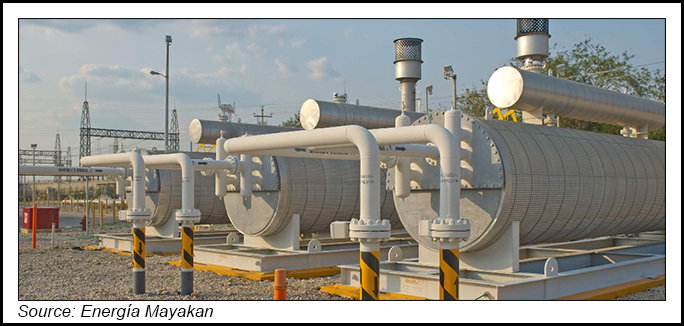BY ANDREW BAKER
NGI (January 20, 2021).- Mexico’s natural gas market has made tremendous strides in recent years, but more connectivity and independent price indexes are needed, according to some of the country’s most important pipeline operators and trading houses.

NGI’s Christopher Lenton, senior editor for Mexico and Latin America, discussed the state of the Mexican market with a group of experts as part of a panel on Wednesday at the Industry Exchange LLC’s 6th Mexico Infrastructure Projects Forum.
“We have to begin to develop the last mile” projects, said Fermaca’s Fernando Alonso Viñas, government relations director. “That is to say, more interconnections with distributors, more interconnections with clients, and more interconnections with other systems.”
Fermaca in September celebrated the start of commercial gas flows on the final section of its long-awaited Waha-to-Guadalajara, aka Wahalajara, pipeline system. The interconnection of this system with Mexico’s Sistrangas national pipeline grid in Guadalajara has helped marketers as well as local distribution companies (LDC), Viñas said, by providing stability and greater reliability to the system.
France’s Engie SA also touted an important milestone in September with the completion of the Cuxtal I interconnection, which links the firm’s Mayakan pipeline on the Yucatan Peninsula with Sistrangas.

Thirsty Customers
The increased connectivity has helped ease supply shortages in the Yucatan region, but it is “not enough to satisfy the demand for natural gas…in the southeast,” said Engie’s Eva Ribera, director of development for natural gas networks in Latin America. Ribera shared the virtual stage with Lenton and Viñas.
The Mayakan system will need to be expanded to supply the new combined cycle power plants announced by state power utility Comisión Federal de Electricidad (CFE) for the peninsula, Ribera said.
Engie is planning to expand the 250 MMcf/d Mayakan system via the Cuxtal II project, which could see system capacity expanded to more than 500 MMcf. The project would also entail an additional section from the pipeline’s current end point in Valladolid to Cancún on the end of the peninsula.
Also on the panel was TC Energy Corp.’s Leonardo Robles, who stressed the importance of finishing pending infrastructure projects such as the Calgary-based operator’s Tuxpan-Tula and Tula-Villa de Reyes pipelines.
The Tula-Villa is slated to enter service by the middle of this year, Robles said. For the Tuxpan, TC remains in talks with the government to find a solution on the project’s stalled indigenous consultation process, which the energy ministry Sener is responsible for conducting.

Mature U.S. Market
North of the border is a different story because of the maturity of the U.S. market, said Mex Gas Supply trading manager Cesar Castro Domínguez. Mex Gas is the U.S. natural gas marketing subsidiary of Mexican national oil company Petróleos Mexicanos (Pemex).
Mex Gasy is the anchor shipper for more than 10 Bcf/d of transport capacity from U.S. production basins to the Mexico border, Castro said.
That Mexico depends on U.S. imports for more than 60% of its gas needs should be seen “as an advantage, not a disadvantage,” said Castro, citing the abundance of cheap gas from areas such as the Permian Basin and the Eagle Ford Shale.
The challenge, however, is that Mexico’s market has not had time to achieve the same level of maturity, Castro said.

He stressed the importance of developing independent price indexes in Mexico, as opposed to the current pricing system which simply calculates the cost of gas at a highly liquid U.S. hub such as the Houston Ship Channel, plus the cost of transport to a given point in Mexico.
The problem with this system, Castro said, is that it does not factor in local supply and demand factors at the point of withdrawal.
“I think we are on our way, and we have to make a big effort,” Castro said. “Our main challenge is for the Mexican market to mature.”
by ANDREW BAKER
Source: Natural Gas Intelligence




